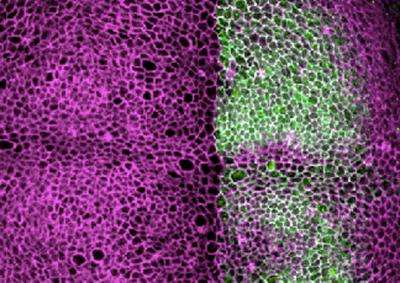Skeleton of cells controls cell multiplication

A research team from Instituto Gulbenkian de Ciencia (IGC; Portugal), led by Florence Janody, in collaboration with Nicolas Tapon from London Research Institute (LRI; UK), discovered that the cell's skeleton can trigger the multiplication of cells through the action of proteins that control cellular rigidity. During this process genes that promote cancer - oncogenes - become activated, leading to tumor formation in living organisms. This study was published in the latest edition of the scientific journal Current Biology.
The cell's skeleton - the cytoskeleton - is composed of a mesh of filaments made of protein. Similar to our skeleton that supports our body and helps us in several daily functions, the cytoskeleton confers the shape of the cell, helps cells moving, and also works as a road that proteins use to move inside the cell and perform their job. For long, scientists have been studying the different roles of the cytoskeleton, but only recent studies done in cultured cells suggested that mechanical forces could impact on how the cytoskeleton is organized and could result in the proliferation of cells. Florence Janody and her team took a step forward and have now shown that proteins of the cytoskeleton, which control mechanical forces, can induce the activation of factors that promote tumor growth in a living organism: the fruit fly (Drosophila melanogaster, in its scientific name). Janody's team observed that when the dynamics of the cell's skeleton changes, this leads to different rearrangements in the mesh of filaments, which can have direct consequences on cell proliferation and tissue overgrowth: if the cytoskeleton becomes less elastic, the cells proliferate faster.
Using both genetic and molecular approaches, the research team identified a protein important for this process, named Zyxin. This protein controls the "correct" assembly of the cytoskeleton to allow cell's normal function. If Zyxin does not work properly, it compromises the cytoskeleton organization, unleashing the function of other proteins that ultimately lead to uncontrolled cell proliferation and tumor development.
Florence Janody says: "The cell's skeleton has been discovered more that 150 years ago, as the cellular structure allowing muscles to create forces. We came to realize only recently that mechanical forces generated by the cell's skeleton dictate the behavior of all cells of the body. The next challenge will be to identify the large diversity of mesh of skeleton filaments built in the cells and characterize their mechanical properties".
Pedro Gaspar, researcher in Florence Janody's laboratory and first author in this study, adds: "We hope that our findings will shed new light to understand how mechanical forces are relayed through the cell skeleton and how they impact on cell proliferation. In the future, we hope these perspectives may inspire new bioengineering approaches in tumor therapy and regenerative medicine."
Since the proteins identified in fruit flies to be involved in this mechanism also exist in other organisms, including humans, it is expected that similar mechanisms also occur in human cells.
Journal information: Current Biology
Provided by Instituto Gulbenkian de Ciencia

















